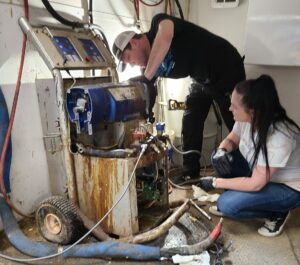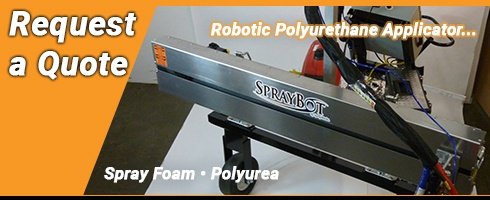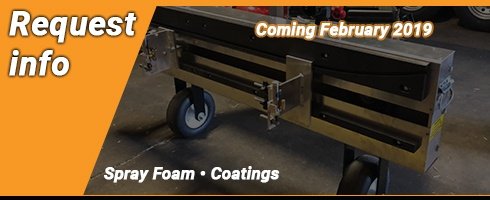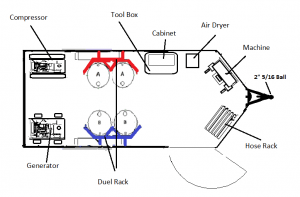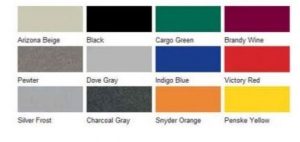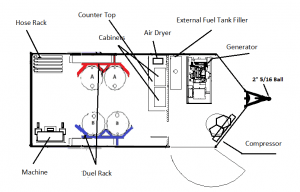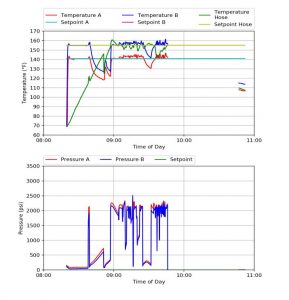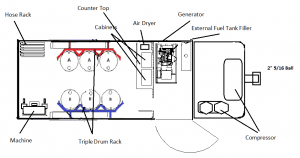Taking proper measures to prevent crystallization in spray foam equipment can minimize your downtime while leaving your customers with results they are highly satisfied with.
In order to effectively prevent spray foam crystallization, be sure to understand the signs of crystals and how to get your equipment back up and running. In this post, we discuss what crystals look like, the complications they cause, and how to keep them at bay.
Signs of Material Crystallization in Spray Foam Equipment
Before we look at how to prevent crystallization in spray foam equipment, let’s talk about why it is problematic. The main issue is that crystals will clog your equipment, leading to bigger issues down the line. Some signs that indicate you are dealing with crystallization buildup include:
- Decreased foam flow
- Complete clogging
- Uneven spray pattern
- Malfunctioning equipment
- A difference in foam quality or curing
On the bright side, there is a chance you will be able to see the crystallization if it is on the end of a hose or spray gun. In terms of appearance, it will look solid. If you notice residue, discoloration, or unusual texture in your spray foam application, you might investigate further to see if these are due to crystallization as well.
Disruptions Caused by Spray Foam Crystallization
Foam chemicals crystallize and create solid particles that clog different components of your equipment, including the nozzles, hoses, and other elements. These blockages disrupt the flow of foam, which results in uneven applications or equipment malfunction.
Problems that spray foam crystallization can cause include:
- Equipment damage – When crystals accumulate in your equipment, it can lead to increased wear and tear. This can result in a rise in maintenance costs, more downtime, and a reduced lifespan for your tools.
- Altered foam quality – It is possible for the foam’s chemical composition to shift and experience property changes when it undergoes crystallization. The result is less effective foam, less effective insulation performance, and issues with curing. Overall, you risk a less effective result when you allow spray foam crystallization.
- Material waste – Crystallization in spray foam equipment can lead to wasted materials because the material may become unusable and need to be discarded. This means you could generate increased material waste.
- Increased downtime – When you encounter crystallization, your projects are more prone to delays due to troubleshooting, cleaning, and other maintenance procedures. Downtime results in project delays, increased costs for labor, and client dissatisfaction.
Now that we have discussed the risks of material crystallization in spray foam equipment, it is time to talk about how to avoid it.
Cleaning, Monitoring, and More
Cleaning your equipment is the first and most obvious way to prevent crystallization in spray foam equipment. While important, it is not the only action you should be taking.
Try the following for the best results:
- Clean equipment – Chemicals left in your machines can react and crystallize. Therefore, it is important to flush the system after use to remove any residual chemicals. If you are looking for the best way to flush your system before storage, be sure to check out our guide.
- Monitor storage climate – Crystallization can form when chemicals are exposed to extreme temperatures, so it is vital to store them in a climate that has the recommended temperature range provided by the manufacturer.
- See chemical compatibility – When cleaning your equipment, it is important to make sure that the cleaning solution is compatible with your foam. Any inappropriate reaction between the two can lead to crystallization.
- Be aware of shelf life – Applying expired foam can increase the chances of material crystallization in spray foam equipment. Therefore, it is important to stay on top of expiration dates and dispose of any foam that has passed its shelf life.
Learning How to Winterize and Store Hoses
When winterizing and storing hoses over an extended amount of time, be sure to clean the system thoroughly. Often, the flush and remaining isocyanate will separate over time. With the isocyanate clinging to the hose walls, equipment often isn’t completely clean with an initial flush.
As a result, when the hose is put back in service, the heating required will cause expansion, which disbonds the settled isocyanate. To help prevent this, be sure to thoroughly flush the system and follow up with a second flush within 3-4 days. This action will allow time for the remaining isocyanate to settle and be cleared with a clean flush, preventing any chances of spray foam crystallization when your equipment is out of use for extended periods of time.
Shop Our Store for Products That Prevent Spray Foam Crystallization
One of the easiest ways to prevent crystallization in your spray foam equipment is to thoroughly clean and flush it out. At SprayWorks Equipment, we offer a variety of solutions that can help you with this, and we have over 100 years of experience that we use to guide and support your business needs. Our team services all 50 states, Mexico, Canada, and abroad with cost-efficient spray rigs and cleaning products.
If you are struggling with spray foam crystallization, we provide desiccant dryers, flushes, lubricants, and more to help alleviate the problem. For instance, desiccant dryers help remove moisture to prevent crystal buildup. We also have products like the Power Flush System and Dynalube that break up crystals and residue while cleaning and lubricating your equipment.
Contact Us with Any Questions You May Have
Be sure to start shopping for products that prevent crystallization in your spray foam equipment today. For more information on spray foam crystallization, feel free to reach out to our team.

